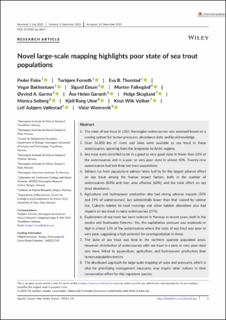| dc.description.abstract | 1. The state of sea trout in 1251 Norwegian watercourses was assessed based on a scoring system for human pressures, abundance data, and local knowledge. 2. Over 16,000 km of rivers and lakes were available to sea trout in these watercourses, spanning from the temperate to Arctic regions. 3. Sea trout were classified to be in a good or very good state in fewer than 25% of the watercourses and in a poor or very poor state in almost 40%. Twenty-nine watercourses had lost their sea trout populations. 4. Salmon lice from aquaculture salmon farms had by far the largest adverse effect on sea trout among the human impact factors, both in the number of watercourses (83%) and river area affected (60%), and the total effect on sea trout abundance. 5. Agriculture and hydropower production also had strong adverse impacts (35% and 19% of watercourses), but substantially lower than that caused by salmon lice. Culverts related to road crossings and other habitat alterations also had impacts on sea trout in many watercourses (27%). 6. Exploitation of sea trout has been reduced in Norway in recent years, both in the marine and freshwater fisheries. Yet, the exploitation pressure was moderate or high in almost 14% of the watercourses where the state of sea trout was poor or very poor, suggesting a high potential for overexploitation in these. 7. The state of sea trout was best in the northern sparsely populated areas. However, distribution of watercourses with sea trout in a poor or very poor state was more linked to aquaculture, agriculture, and hydropower production than human population density. 8. The developed approach for large-scale mapping of state and pressures, which is vital for prioritizing management measures, may inspire other nations in their conservation effort for this important species. acidification, anthropogenic pressures, brown trout (Salmo trutta), culverts, exploitation, hazardous substances, salmon lice (Lepeophtheirus salmonis), sewage | |
